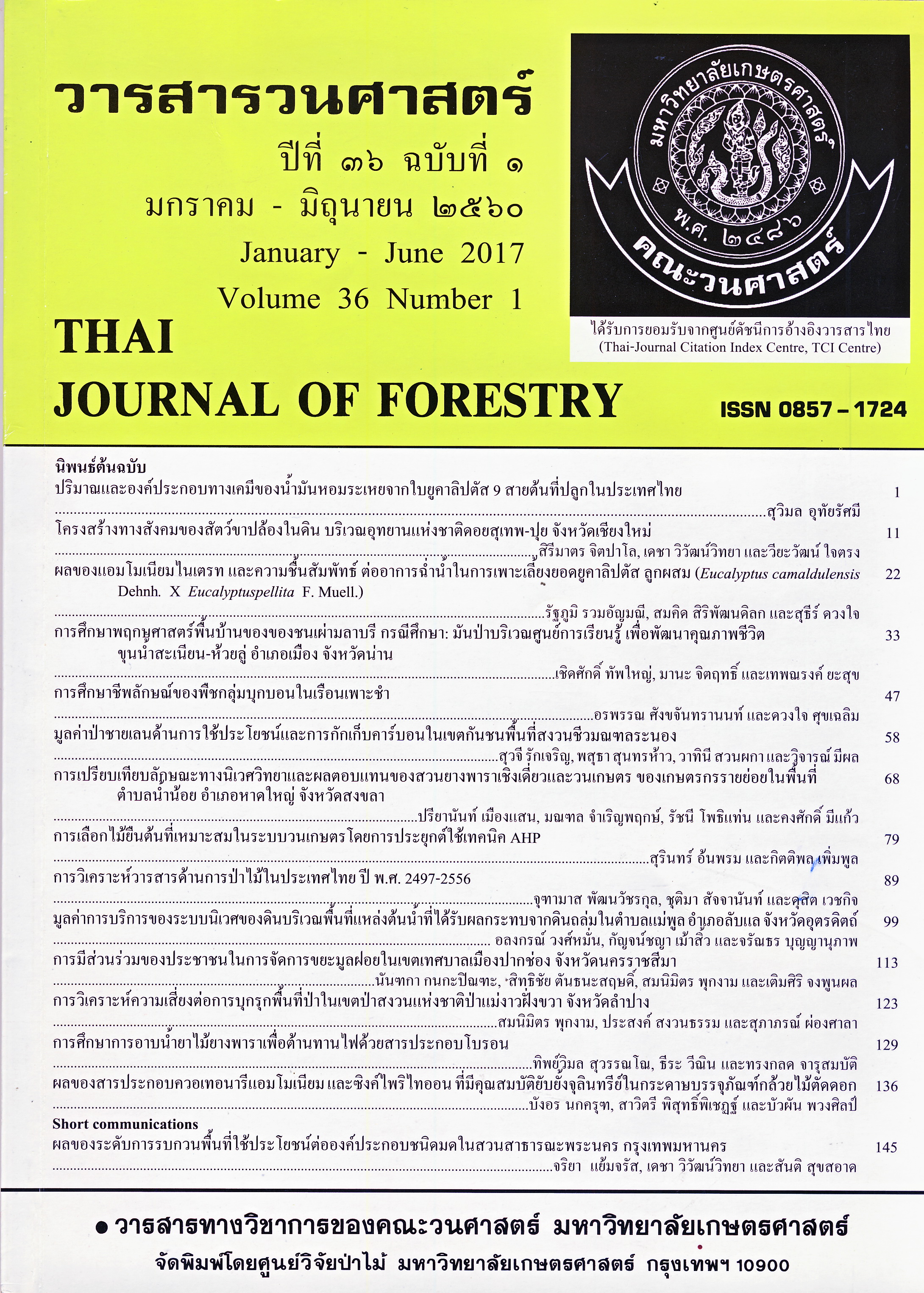โครงสร้างทางสังคมของสัตว์ขาปล้องในดิน บริเวณอุทยานแห่งชาติดอยสุเทพ-ปุย จังหวัดเชียงใหม่
Main Article Content
บทคัดย่อ
การศึกษาความมากมายของสังคมสัตว์ขาปล้องในดิน บริเวณอุทยานแห่งชาติดอยสุเทพ-ปุย จังหวัดเชียงใหม่ ดำเนินการระหว่างเดือนกรกฎาคม พ.ศ. 2556 ถึง เดือนพฤษภาคม พ.ศ. 2557 มีวัตถุประสงค์เพื่อศึกษาการเปลี่ยนแปลง ความมากมายและกลุ่มสัตว์ขาปล้องในดินในป่าเต็งรัง ป่ารอยต่อ และป่าดิบเขา โดยการสุ่มเก็บตัวอย่างดินในป่าเต็งรัง ป่ารอยต่อ และป่าดิบเขา ด้วย Soil cores ขนาดพื้นที่หน้าตัด 25 ตารางเซนติเมตร ลึก 4 เซนติเมตร จำนวน 20 ตัวอย่าง ในพื้นที่ขนาด 25 × 10 เมตร ทำการสำรวจภาคสนามทุกๆ 2 เดือน
การศึกษา พบสัตว์ขาปล้องในดินทั้งหมด 22 กลุ่ม ความมากมายเฉลี่ยทั้งพื้นที่ เท่ากับ 60,737.78 ตัว/ตาราง เมตร สัตว์ขาปล้องในดินกลุ่ม Acari และ Collembola เป็นกลุ่มที่มีความมากมายสูงที่สุด เท่ากับ 12,970.37±2368.49 และ 4,902.22±824.82 ตัว/ตารางเมตร ตามลำดับ รวมกันแล้วคิดเป็น 88.27 เปอร์เซ็นต์ของสัตว์ขาปล้องในดินทั้งหมด ป่าเต็งรังพบสัตว์ขาปล้องในดินมากที่สุด (21 กลุ่ม) ความมากมายของสัตว์ขาปล้องในดินเฉลี่ยมากที่สุดในป่ารอยต่อ เท่ากับ 22,991.11±4539.30 ตัว/ตารางเมตร สัตว์ขาปล้องในดินกลุ่ม Acari (13,937.78±2347.81) และ Collembola (6,706.67±1139.53) พบมากทั้งป่าเต็งรัง (11,737.78±2261.68 และ 1,417.78±276.55 ตัว/ตารางเมตร) ป่ารอยต่อ (13,937.78±2347.81 และ 6,706±1139.53) และป่าดิบเขา (13,235.56±2495.99 และ 6,582.22±1058.38) ในฤดูแล้ง พบกลุ่มและความมากมายของสัตว์ขาปล้องในดินมากกว่าในฤดูฝน โดยฤดูแล้ง พบ 22 กลุ่ม (22,924.44±4567.44) และ ฤดูฝน พบ 18 กลุ่ม (17547.41±4103.10) ดังนั้นจากการศึกษาในครั้งนี้แสดงให้เห็นว่าในทุกพื้นที่กลุ่มสัตว์ขา ปล้องในดินที่สามารถครอบครองพื้นที่เป็นกลุ่มเด่น คือ Acari และ Collembola
การศึกษาในครั้งนี้ สามารถเป็นข้อมูลพื้นฐานที่จะใช้เป็นตัวชี้วัดสุขภาพของป่าไม้
Downloads
Article Details
ข้าพเจ้าและผู้เขียนร่วม (ถ้ามี) ขอรับรองว่า ต้นฉบับที่เสนอมานี้ยังไม่เคยได้รับการตีพิมพ์และไม่ได้อยู่ในระหว่างกระบวนการพิจารณาตีพิมพ์ลงในวารสารหรือสิ่งตีพิมพ์อื่นใด ข้าพเจ้าและผู้เขียนร่วม (ถ้ามี) ยอมรับหลักเกณฑ์และเงื่อนไขการพิจารณาต้นฉบับ ทั้งยินยอมให้กองบรรณาธิการมีสิทธิ์พิจารณาและตรวจแก้ต้นฉบับได้ตามที่เห็นสมควร พร้อมนี้ขอมอบลิขสิทธิ์ผลงานที่ได้รับการตีพิมพ์ให้แก่วารสารวนศาสตร์ คณะวนศาสตร์ มหาวิทยาลัยเกษตรศาสตร์ กรณีมีการฟ้องร้องเรื่องการละเมิดลิขสิทธิ์เกี่ยวกับภาพ กราฟ ข้อความส่วนใดส่วนหนึ่ง หรือ ข้อคิดเห็นที่ปรากฏในผลงาน ให้เป็นความรับผิดชอบของข้าพเจ้าและผู้เขียนร่วม (ถ้ามี) แต่เพียงฝ่ายเดียว และหากข้าพเจ้าและผู้เขียนร่วม (ถ้ามี) ประสงค์ถอนบทความในระหว่างกระบวนการพิจารณาของทางวารสาร ข้าพเจ้าและผู้เขียนร่วม (ถ้ามี) ยินดีรับผิดชอบค่าใช้จ่ายทั้งหมดที่เกิดขึ้นในกระบวนการพิจารณาบทความนั้น”
เอกสารอ้างอิง
สำนักอุทยานแห่งชาติ ศูนย์ข้อมูลสารสนเทศอุทยานแห่งชาติ. 2558. ดอยสุเทพ-ปุย (Doi Suthep- Pui). แหล่งที่มา: http://www.park.dnp.go.th/ visitor/nationparkshow.php?PTA_CODE=1024, 5 พฤษภาคม 2558
Booher, E.C.J., C.M. Greenwood and J.A Hattey. 2012. Effect of Soil Amendments on Soil Microarthropods in Continuous Maize in Western Oklahoma. Southwestern Entomologist 37 (1): 23-30.
Kardol, P., W.N. Reynolds, R.J. Norby and A.T. Classen. 2011. Climate change effects on soil microarthropod abundance and community structure. Applied Soil Ecology 47: 37-44.
Lavelle, P., T. Decaens, M. Aubert, S. Barot, M. Blouin, F. Bureau, P. Margerie, P. Mora and J.P. Rossi. 2006. Soil invertibrates and ecosystem services. European Journal of Soil Biology 42: 3-15.
Marra, J.L. and R.L. Edmonds. 2005. Soil Arthropod Responses to Different Patch Types in a Mixed-Conifer Forest of the Sierra Nevada. Forest Science 51 (3): 255-265.
Moldenke, A.R. and J.D. Lattin. 1990. Density and diversity of arthropods as “biological probes” of complex soil phenomena. NW Environ. J. 6: 409-410
Szanser, M. 2012. The Impact of Shelterbelts on Mulch Decomposition and Colonization by Fauna in Adjacent Fields Diversity of Ecosystems 289-298.
Wiwatwitaya, D. and H. Takeda. 2005. Seasonal changes in soil arthropod abundance in the dry evergreen forest of north-east Thailand, with special reference to collembolan communities. Ecological Research 20 (1): 59-70.


